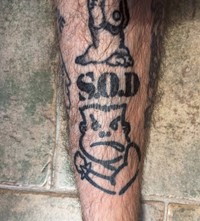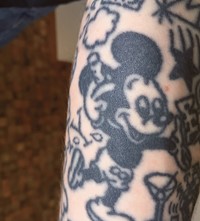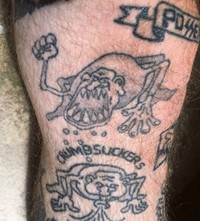In an excerpt from TTT: Tattoo, the graphic designer famed for creating Palace’s infamous logo shares his journey as a tattoo artist
- TextAnother Man
The following article is an excerpt taken from TTT: Tattoo by TTTism and Nicholas Schonberger, a new book exploring contemporary tattoo culture around the globe. This tome features work from over 300 tattoo studios and tattoo artists around the world, including Fergus “Fergadelic” Purcell. A graphic designer by trade, Purcell has worked with brands including Marc Jacobs, Marc by Marc Jacobs and Ashley Williams, as well as co-founding his own label, the popular streetwear brand Aries. He is perhaps best known for his work with Palace Skateboards, though – he’s the man responsible for the brand’s now-ubiquitous Penrose triangle logo. Butm as you’ll read below, clothes are not Purcell’s only canvas: skin is too...
Released in 2006, Thomas K. Jeppe’s Home Made Tattoos Rule documents the DIY tattoo scene of the author’s native Australia, and also New Zealand. The book’s cover star, Fergus Purcell, met Jeppe while visiting Australia from England, and although the meeting was circumstantial, the resulting image made Purcell (and his torso) something of a stick-and-poke icon.
Purcell (who studied at Central Saint Martins in London and is famed for his graphic work for Marc Jacobs and Palace Skateboards) first saw tattoos on the bodies of builders working on his parents’ home. “They had these really intriguing tattoos, and were role models as far as wanting to get decorated.” At 20 or 21, Purcell was tattooed by Lal Hardy, and at 28 he started tattooing himself at home. “I wanted a lot of tattoos, but I had fuck-all money.”
At the time he was working on the periphery of the streetwear and fashion industry, building fledgling label Silas with friends from London’s iconic Slam City Skates, and advancing his interest in subcultures. In his aesthetic there is a mix of the direct, graphic punch of American hardcore and the low-fi polish of early computer graphics (his proficiency in Apple programs dates to his Saint Martins days).
While Purcell’s personal tattooing was – and remains – largely on his own body, it has not been without interaction with the professional tattoo world. In fact, he credits visits to Into You as pivotal in learning to ink properly. Having previously got a tattoo done at the shop, he returned as a walk-in, to get someone else’s tattoo fixed.
“Unbelieveably,” Purcell recalls, “I got Xed LeHead, who never did this kind of stuff. We hit it off and he got really stoked on my scattering of inept, homemade tattoos (done with a sewing needle!). Then and there he became my tattoo mentor. He was instrumental to my development as a tattooer. I can’t stress enough how important he was. That was my beginning. The enthusiasm, excitement and approval, but also the actual tool [a gifted five-round needle] … things really took off from there.”
This extract is taken from TTT: Tattoo by TTTism and Nicholas Schonberger, by Laurence King Publishing, is out now















